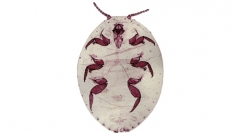

 Zoosystema
43 (18) - Pages 341-363
Zoosystema
43 (18) - Pages 341-363Coffee (Rubiaceae: Coffea spp.) is the host-plant of at least 214 scale insect species (Hemiptera: Coccomorpha). In this study, scale insects were collected from the roots of Coffea arabica Linnaeus, 1753 in five provinces of Colombia, South America, and the adult females were prepared as microscope slide mounts for identification. Four new scale species are described, based on the external morphology of the adult females: Newsteadia andreae n. sp. (Ortheziidae Amyot & Serville, 1843) differs from other Newsteadia Green, 1902 species by antennal length, presence of two spines on the trochanter, and absence of tubular ducts and groups of quadrilocular pores posterior to the vulva. Distichlicoccus takumasae n. sp. (Pseudococcidae Cockerell, 1905) is distinguished by having a few oral rim tubular ducts on both dorsum and venter and absence of circulus. Paraputo nasai n. sp. (Pseudococcidae) is characterized by having 16 pairs of cerarii, uniformity of length of its dorsal setae on all segments, and the sizes of oral collar tubular ducts. Pseudococcus luciae n. sp. (Pseudococcidae) is diagnosed by having few oral collar and oral rim tubular ducts, few multilocular disc pores, a small circulus and the eye not being associated with any sclerotized area or discoidal pores. The list of scale insect species on coffee roots in Colombia is updated to 65 species. Taxonomic keys to the New World species of Newsteadia, Distichlicoccus Ferris, 1950 and Paraputo Laing, 1902 are provided. To identify Pseudococcus luciae n. sp., modifications are provided for use with the existing taxonomic keys to New World and Neotropical mealybugs.
Coccoidea, Coffea arabica, hypogeal scale insects, mealybugs, Neotropical, new species